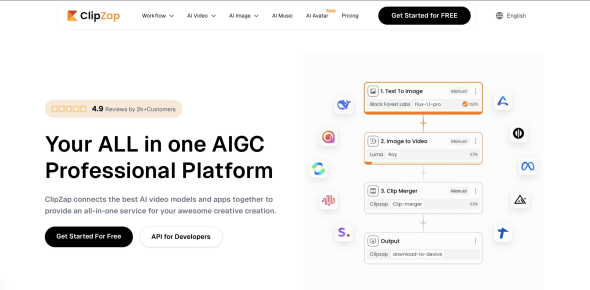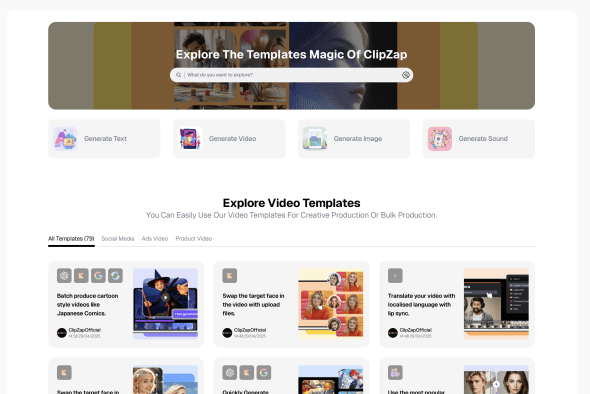ClipZap: An AI Workflow for Content Creation
ClipZap is an application that automates the creation of videos, images, and music using artificial intelligence. Developed by JUNOVERSE TECHNOLOGY PTE. LTD, launched in 2025, this tool combines leading AI models from Google, OpenAI, Runway, and others into a single interface. ClipZap is designed for a wide range of users, including individual creators, social media managers, and corporate marketing departments. Its main function is to improve efficiency.
ClipZap changes traditional content creation by replacing the need for multiple, separate ai generated content platforms with one unified and automated system. This tool allows users to build a complete ai workflow for content creation, saving time and making large-scale production more manageable.
Best Use Cases of ClipZap
- Social Media Managers: For professionals who need a constant stream of new material, ClipZap automates the content production cycle. It can generate a video from text, create related images, compose a music track, and schedule the final post. This directly addresses the problem of high-volume content demand.
- Marketing Professionals: Marketers can use ClipZap to produce targeted ad campaigns in large quantities. The platform generates numerous video and image variations for different audience segments. This is a practical method for creating personalized content without a proportional increase in manual work.
- Content Creators and Storytellers: This platform enables creators to produce visual media without requiring deep technical knowledge. It lowers the barrier to video production by allowing users to generate video narratives from text or image inputs, making it a useful tool for aigc for video.
- Global Businesses: For companies expanding into international markets, ClipZap’s video translation feature is highly useful. It simplifies the process of dubbing and subtitling videos, making communication with a global audience more straightforward.
Unified Platform: ClipZap combines tools for video, image, and music generation, removing the need to use and pay for multiple applications.
Effective Workflow Automation: Its central strength is its ability to connect different AI models in a sequence, creating automated content pipelines that reduce manual effort.
Access to Quality AI Models: The platform incorporates models from well-regarded sources like Google, OpenAI, and Runway.
Increased Efficiency: By automating many steps, ClipZap speeds up the content creation process, permitting greater output.
Intuitive Interface: The platform is designed to be straightforward and usable for people with varying levels of technical skill.
Freemium Availability: The free tier provides a way to test the platform's main functions before buying a paid plan.
Scalable for Different Needs: ClipZap offers plans suitable for individual creators as well as larger organizations.
Initial Learning Period: The advanced workflow automation features can be complex and may take some time for new users to understand fully.
Limited Branding Options: The tool could offer more detailed customization options for applying specific brand elements to generated content.
Credit Limits on Free Plan: The free plan’s credits can be used up quickly, especially when generating high-resolution video.
Ongoing Development: As a newer platform, some of its more advanced features are still being introduced.
-
AI Video Generator: Creates videos from text or image inputs using models like Google Veo3 and Kling 2.1.
-
AI Image Generator: Produces images from text descriptions.
-
AI Workflow Editor: A visual editor for building automated sequences of content creation tasks, central to its ai workflow for content creation capabilities.
-
AI Music Generator: Composes original, royalty-free music for use in videos.
-
AI FaceSwap: A feature for swapping faces in video clips.
-
Video Translator: Translates and creates new audio tracks for videos in multiple languages.
-
Model Integration: Connects directly with AI models from OpenAI, Runway, Pika Labs, and other providers.
-
Automated Publishing: Can schedule and post content to social media platforms.
-
Template Library: Includes pre-made templates to help users start new projects.
-
Credit-Based System: The platform operates on a credit system where users pay for the amount of generation they need.
 Homepage ClipZap
Homepage ClipZap
 ClipZap-Gallery
ClipZap-Gallery
Frequently Asked Questions
-
What is ClipZap?
ClipZap is an all-in-one AI platform that automates video, image, and music creation through an integrated workflow editor. -
Who developed ClipZap?
ClipZap was developed by the Singapore-based company JUNOVERSE TECHNOLOGY PTE. LTD. -
Does ClipZap have a free trial?
ClipZap offers a freemium model with a free tier that includes basic services and limited credits. -
What AI models does ClipZap use?
ClipZap integrates top-tier AI models, including Google Veo3, Kling 2.1, OpenAI, Runway, and Pika Labs. -
Can I use ClipZap for commercial purposes?
Yes, content created with paid plans can be used for commercial purposes without watermarks. -
What are the main limitations of the free plan?
The free plan has limited credits, generates watermarked outputs, and has slower processing speeds. -
How does AIGC work?
AI-Generated Content (AIGC) operates using large machine learning models. These models are trained on vast datasets of existing text, images, or sounds, allowing them to learn patterns and structures. When a user provides a prompt, the AI uses this learned knowledge to generate new, original content that matches the user’s request. -
Can AI-generated content be copyrighted?
The copyright eligibility of AI-generated content is a complex legal topic. In the United States, the U.S. Copyright Office has stated that works created solely by an AI without sufficient human authorship do not qualify for copyright protection. Copyright law requires a human creator, so the level of human creative input is a key factor.
Tech Pilot’s Verdict on ClipZap
I tested ClipZap to verify its effectiveness as a unified tool for AI-generated content. The main goal was to assess its workflow automation and compare its output to that of individual, specialized ai generated content platforms.
First, I examined the AI Workflow Editor, which is the platform’s most significant feature. I constructed a pipeline to produce a short promotional video. The sequence was set to 1) generate a script, 2) create a series of images from that script, 3) animate the images into a video, and 4) compose background music. Building this ai workflow for content creation was direct. In under an hour, the system was ready to produce a complete video from a single text instruction. The efficiency of this process was its greatest strength. While the quality of each individual element was adequate, the ability to generate the entire package at once is what makes the tool valuable.
Next, I tested the AI Video Generator with a direct text-to-video instruction for an aigc for video test: “A cinematic shot of a futuristic city at sunset, with flying cars weaving between skyscrapers.” The resulting clip was visually competent and comparable in quality to other dedicated text-to-video generators. The motion was consistent and the details were clear. However, more complex instructions sometimes produced small visual errors, which is a common limitation in the current field of automated video production.
ClipZap’s pricing is based on credits, which is a fair model considering it replaces multiple subscriptions. The free plan is sufficient for initial testing, but consistent use will require a paid plan. The basic features are easy to learn, but the workflow editor requires more practice. The platform would benefit from a larger library of tutorials and pre-built workflow examples.
Top Alternatives to ClipZap
- Leap AI: A direct competitor, Leap AI provides a visual, drag-and-drop interface for building complex AI workflows. It consolidates language, image, and voice models to automate multi-step processes, like creating a complete video from a single topic. Leap AI is a strong choice for users who want a dedicated and flexible AI workflow builder to create custom content pipelines from the ground up.
- Make (formerly Integromat): Make is a general automation platform that serves as a highly versatile alternative. Its visual editor connects hundreds of applications, including AI models for text, voice, and video. Users can build custom content workflows that integrate with business tools like CRMs or Google Sheets, but they must manage their own subscriptions to the connected AI services. Make is ideal for those needing deep customization and integration with a wider business software ecosystem.
- n8n: n8n is a source-available workflow automation tool similar to Make. It uses a node-based visual editor to connect AI services like OpenAI and Hugging Face into automated content pipelines. Its key advantage is the option for self-hosting, offering greater control over data privacy. n8n is best suited for technical users or businesses that prioritize data security and want to run the platform on their own infrastructure.
Final Verdict
ClipZap’s distinct advantage is its all-in-one, user-friendly nature. It packages the AI models, the workflow editor, and the credits into a single, cohesive platform. For creators and marketers who want a powerful automation tool without the complexity of managing multiple APIs and subscriptions, this ai workflow is a highly functional and practical choice.

